11 October 2017
Pompeii vs. Herculaneum
Posted by Callan Bentley
What’s missing from this picture of Pompeii, outside of Naples in west central Italy?

I’ll give you a hint: here’s a photo of nearby Herculaneum:

I visited both sites this summer, and was struck by some of the differences.
First, what they have in common: Both towns were satellite Roman communities that were snuffed out in AD 79, when the volcano Vesuvius erupted violently. Those residents who didn’t escape during the early stages of the eruption were buried. Almost two thousand years later, their remains may be viewed in the context of the archaeological sites their towns have become.
The difference between the two photos above is that at Pompeii, excavations have removed almost all the pyroclastic material (ash and lapilli) that killed the people and preserved the town. At Herculaneum, much of it remains in place. While Pompeii pokes out into the air as you might expect a village to, Heculaneum feels like an excavation: it’s a hole in the ground. The walls of that hole are pyroclastics that the surrounding city have been constructed upon.

Today, let’s explore both sites together.
Some images from Pompeii:

There are plenty of vantages of Vesuvius, the great threat, off in the distance.

It’s a beautiful place – hauntingly beautiful if you think about what happened here.

The roads and floors:



Some art from Pompeii:
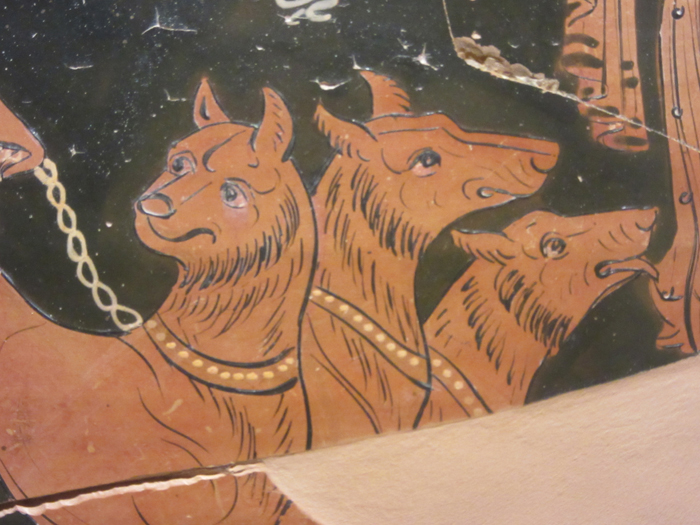


Building materials varied, but included thin bricks and blocks of travertine, here accompanied by vesicular basalt for artistic effect, and also a block of carved marble (modern) for the sign:

In some places, the basalt (quite common in the area because of the neighboring volcano) dominates:

Blocks of travertine show the external molds of plants growing adjacent to the spring:


Full body casts of the dead at the Garden of the Refugees:

These striking forms resulted when human beings (likely slaves) were buried by a pyroclastic flow. The pyroclastics were already meters deep at the time of their demise, and their masters had likely fled the city. The slaves’ bodies rotted away over time (save for some bone material) and yet the surrounding envelope of ash had enough structural integrity to remain standing and preserve the shape of their bodies. Later infilling of this external mold with plaster of Paris created a cast of the original three-dimensional shape of their bodies.
The cast of a child who died almost two millennia ago:

Two millennia later, a child examines the lapilli that entombed this city:

This is the only pyroclastic material I observed in Pompeii; everything else must have been cleared away – and a tremendous amount of it, too. It seems to me that there is a missed opportunity for some geological education here. By seeking not to obscure the gorgeous archaeological features of Pompeii, the geological “murder weapon” has been removed from the scene.
Herculaneum, in contrast, sits in a hole in the pyroclastic deposits, surrounded by urban greater Naples:
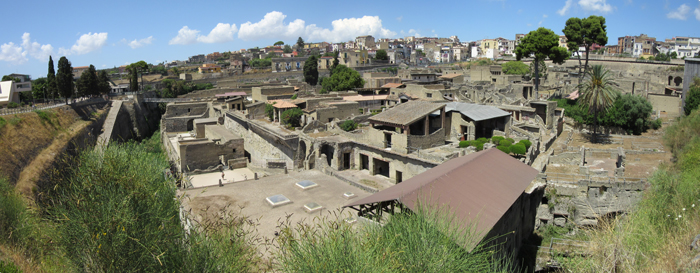
Vesuvius can be seen looming in the distance here, too.

Here’s a room (now missing the wall closest to us, and the roof), where you can see dune-scale cross-bedding moving in from the former door (on the right) to fill the interior (on the left):
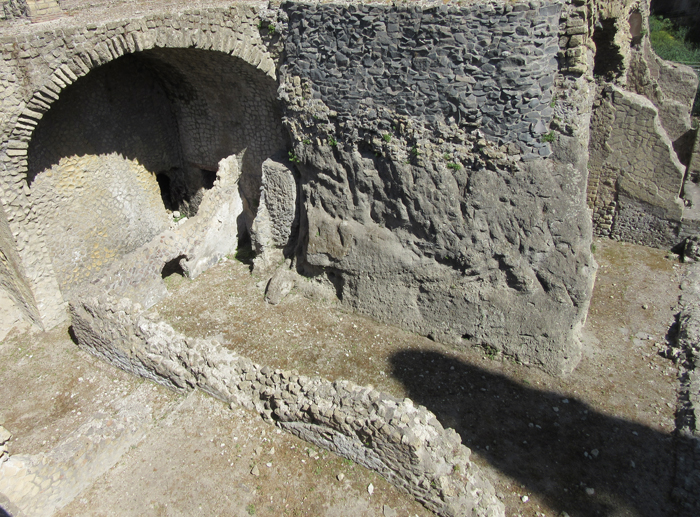
Zooming in on the cross-bedding:
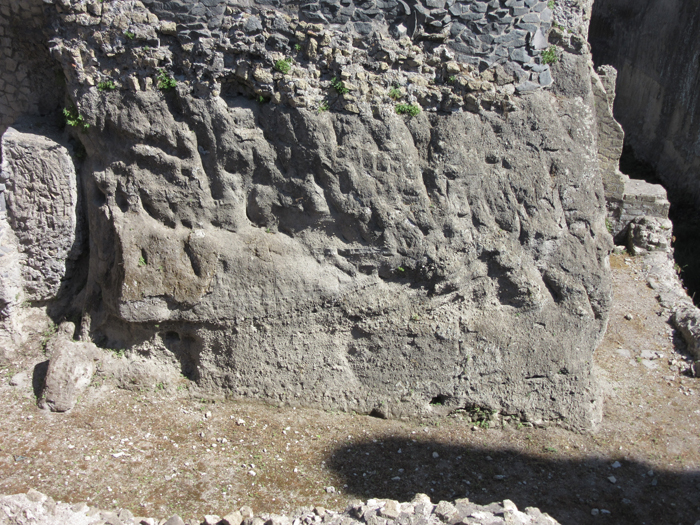
Annotated to show the flow direction:
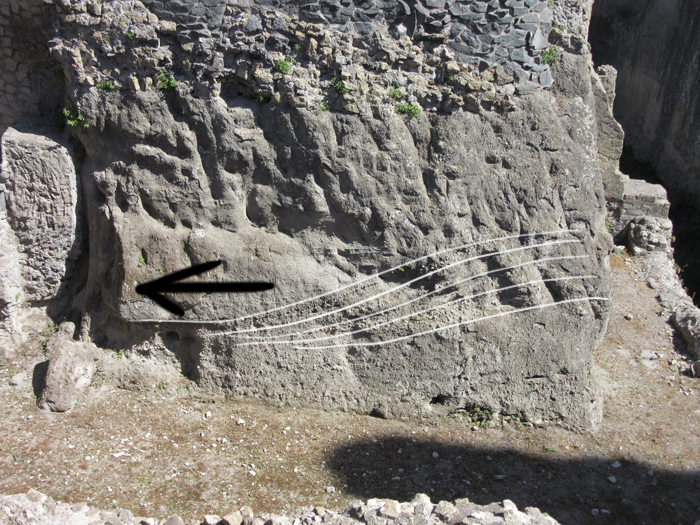
Herculaneum also preserves the bodies of the dead, but here they are skeletons.

These macabre remains are in a series of boat shelters at the former harbor of Herculaneum: the low archways along this wall:

It’s a sobering view.


One of the striking aspects of Herculaneum’s archeology is the preservation of carbonized wood at the site. Here is a bed that still persists, 2000 years after it was built: absolutely remarkable!

Some of this wood remains in architectural position, holding up walls and ceilings (though now reinforced with modern additions):


Along the walls of the excavation pit, you can see additional buildings, not yet revealed. The lapilli and fragments of the carbonized wood are crumbling into the open pit:

Some art at Herculaneum:
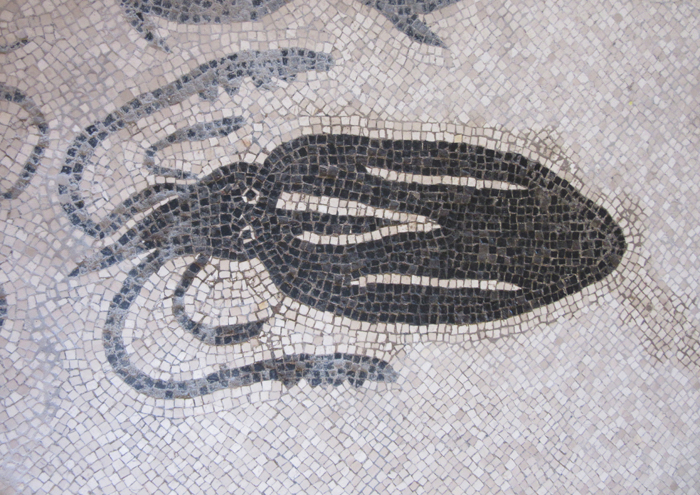



Differential weathering of blocks of yellow tuff, relative to the mortar that holds them in place:

Finally, here’s a stone* mill for making flour, one of two located in a bakery in Herculaneum:

*porphyritic vesicular basalt
Both sites are extraordinary windows into the past. They offer views of life during the heyday of the Roman Empire. Each has its strengths. Pompeii is enormous. We walked its streets for six hours in the blazing sun and hardly visited the same spot twice. Herculaneum (the excavated portion, anyhow) is much smaller – only a few blocks. Visitors have greater liberty to enter the buildings at Herculaneum, and it’s less mobbed by visitors. For these reasons, coupled with the visceral sense of being in the volcanic deposit, I think Herculaneum was the more powerful visitor experience. Ideally though, a stronger sense of how this violent day went down can be achieved by visiting both sites in tandem.


 Callan Bentley is Associate Professor of Geology at Piedmont Virginia Community College in Charlottesville, Virginia. He is a Fellow of the Geological Society of America. For his work on this blog, the National Association of Geoscience Teachers recognized him with the James Shea Award. He has also won the Outstanding Faculty Award from the State Council on Higher Education in Virginia, and the Biggs Award for Excellence in Geoscience Teaching from the Geoscience Education Division of the Geological Society of America. In previous years, Callan served as a contributing editor at EARTH magazine, President of the Geological Society of Washington and President the Geo2YC division of NAGT.
Callan Bentley is Associate Professor of Geology at Piedmont Virginia Community College in Charlottesville, Virginia. He is a Fellow of the Geological Society of America. For his work on this blog, the National Association of Geoscience Teachers recognized him with the James Shea Award. He has also won the Outstanding Faculty Award from the State Council on Higher Education in Virginia, and the Biggs Award for Excellence in Geoscience Teaching from the Geoscience Education Division of the Geological Society of America. In previous years, Callan served as a contributing editor at EARTH magazine, President of the Geological Society of Washington and President the Geo2YC division of NAGT.
Awesome share of one of my bucket lists – thanks!
Thank you for sharing – my students are given a nice look into the enormous devastation the Vesuvius had caused.
And to see the differences between the two cities is really awesome!
Thanks again,
Mara Leerdam
Geography Teacher
Sint-Janslyceum, ‘s-Hertogenbosch, the Netherlands (Europe…)
http://www.sjl.nl
Excellent article and pictures, thank you!!
I just returned from seeing both sites and your photos and descriptions greatly added to my understanding and my memories. I wish I had 6 hours alone in Pompeii (without a guide) to just feel the place and its inhabitants.
I came across your blog while reading Mary Beard’s Pompeii. Thank you for the insights
It all makes sense once you know the difference in the demise of the two sites; the burying in ash, the wood charring and then excavation of Herculaneum once situated on the shore edge, as opposed to the ‘hill’ site of Pompeii destroyed in a deluge of rock & lava ……
I just returned from touring both and I enjoyed Herculaneum best for several reasons. First, it wasn’t overflowing with tourists. The second was everything you described here. The difference in their destruction mattered too. Pompeii was engulfed in fire and therefore didn’t have many of the items that Herculaneum had. Things like wood artifacts.
One display touched me the most. It is a mosaic picture of the family that lived in one of the houses, and in the picture there is a side table that has some pottery, etc on top. Then, below the display of that mosaic, the actual table is still in tact! It showed the reality of the lives of the people who lived there. Almost like a Polaroid photo!
I wish I knew how to share my photo of it because it’s quite remarkable!